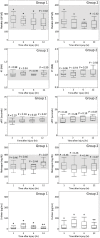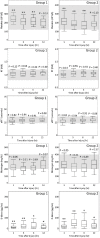Age-related differences in fibrinolytic parameters in patients with acute traumatic brain injury
- PMID: 28966820
- PMCID: PMC5609444
- DOI: 10.4103/sni.sni_56_17
Age-related differences in fibrinolytic parameters in patients with acute traumatic brain injury
Abstract
Background: Coagulopathy and old age have been associated with poor outcomes in traumatic brain injury (TBI) patients; however, the relationships of coagulopathy and age with the acute phase of TBI remain unclear. We hypothesized that coagulation/fibrinolytic abnormalities are more severe in older patients in the acute phase of TBI and may explain, in part, their poor outcome.
Methods: We analyzed the relationship between coagulation/fibrinolytic parameters and age in the acute phase of TBI by retrospectively evaluating 274 patients with initial blood samples obtained no more than 1 hour after injury. Measurement of platelet count, prothrombin time, activated partial thromboplastin time, plasma levels of fibrinogen, and D-dimer was done in the emergency department on arrival as well as 3, 6, and 12 hours following injury. Values were compared between patients aged 16-55 years (group 1) and those aged older than 55 years (group 2) with an Abbreviated Injury Score (AIS)-head of 3-5 to identify any relationship between these parameters and age.
Results: When groups 1 and 2 were matched for AIS-head, plasma levels of D-dimer in group 2 were significantly higher than those in group 1 from hospital admission to 12 hours after injury. The Glasgow Outcome Scale scores at 3 months post-injury of group 2 with AIS 4 and 5 were significantly lower than those of group 1 (both P < 0.0001).
Conclusions: Fibrinolytic abnormalities are more severe in older acute-phase TBI patients, which may be a factor associated with their poor prognosis.
Keywords: Age; D-dimer; coagulopathy; fibrinolysis; traumatic brain injury.
Conflict of interest statement
There are no conflicts of interest.
Figures



Similar articles
-
Age-Related Differences in the Time Course of Coagulation and Fibrinolytic Parameters in Patients with Traumatic Brain Injury.Int J Mol Sci. 2020 Aug 5;21(16):5613. doi: 10.3390/ijms21165613. Int J Mol Sci. 2020. PMID: 32764459 Free PMC article.
-
Time Course of Coagulation and Fibrinolytic Parameters in Patients with Traumatic Brain Injury.J Neurotrauma. 2016 Apr 1;33(7):688-95. doi: 10.1089/neu.2015.4039. Epub 2015 Nov 20. J Neurotrauma. 2016. PMID: 26414158
-
Time course of coagulation and fibrinolytic parameters in pediatric traumatic brain injury.J Neurosurg Pediatr. 2021 Aug 20;28(5):526-532. doi: 10.3171/2021.5.PEDS21125. Print 2021 Nov 1. J Neurosurg Pediatr. 2021. PMID: 34416724
-
Trauma-induced coagulopathy: standard coagulation tests, biomarkers of coagulopathy, and endothelial damage in patients with traumatic brain injury.J Neurotrauma. 2013 Feb 15;30(4):301-6. doi: 10.1089/neu.2012.2612. Epub 2013 Feb 5. J Neurotrauma. 2013. PMID: 23134525
-
Acute and delayed mild coagulopathy are related to outcome in patients with isolated traumatic brain injury.Crit Care. 2011;15(1):R2. doi: 10.1186/cc9399. Epub 2011 Jan 5. Crit Care. 2011. PMID: 21208418 Free PMC article.
Cited by
-
Age-Related Differences in the Time Course of Coagulation and Fibrinolytic Parameters in Patients with Traumatic Brain Injury.Int J Mol Sci. 2020 Aug 5;21(16):5613. doi: 10.3390/ijms21165613. Int J Mol Sci. 2020. PMID: 32764459 Free PMC article.
-
Early Thrombocytopenia at Hospital Admission Predicts Mortality in Patients with Non-Isolated Severe Traumatic Brain Injury.Biomedicines. 2024 Nov 26;12(12):2702. doi: 10.3390/biomedicines12122702. Biomedicines. 2024. PMID: 39767609 Free PMC article.
-
Early thrombocytopenia is associated with an increased risk of mortality in patients with traumatic brain injury treated in the intensive care unit: a Finnish Intensive Care Consortium study.Acta Neurochir (Wien). 2022 Oct;164(10):2731-2740. doi: 10.1007/s00701-022-05277-9. Epub 2022 Jul 15. Acta Neurochir (Wien). 2022. PMID: 35838800 Free PMC article.
References
-
- Allard CB, Scarpelini S, Rhind SG, Baker AJ, Shek PN, Tien H, et al. Abnormal coagulation tests are associated with progression of traumatic intracranial hemorrhage. J Trauma. 2009;67:959–67. - PubMed
-
- Association for the Advancement of Automotive Medicine. The Abbreviated Injury Scale (AIS) 1998 Revision. Des Plaines, Illinois: Association for the Advancement of Automotive Medicine; 1998.
-
- Cadroy Y, Pierrejean D, Fontan B, Sie P, Boneu B. Influence of aging on the activity of the hemostatic system: Prothrombin fragment 1+2, thrombin-antithrombin III complexes and D-dimers in 80 healthy subjects with age ranging from 20 to 94 years. Nouv Rev Fr Hematol. 1992;34:43–6. - PubMed
-
- Carrick MM, Tyroch AH, Youens CA, Handley T. Subsequent development of thrombocytopenia and coagulopathy in moderate and severe head injury: Support for serial laboratory examination. J Trauma. 2005;58:725. - PubMed
LinkOut - more resources
Full Text Sources
Other Literature Sources
